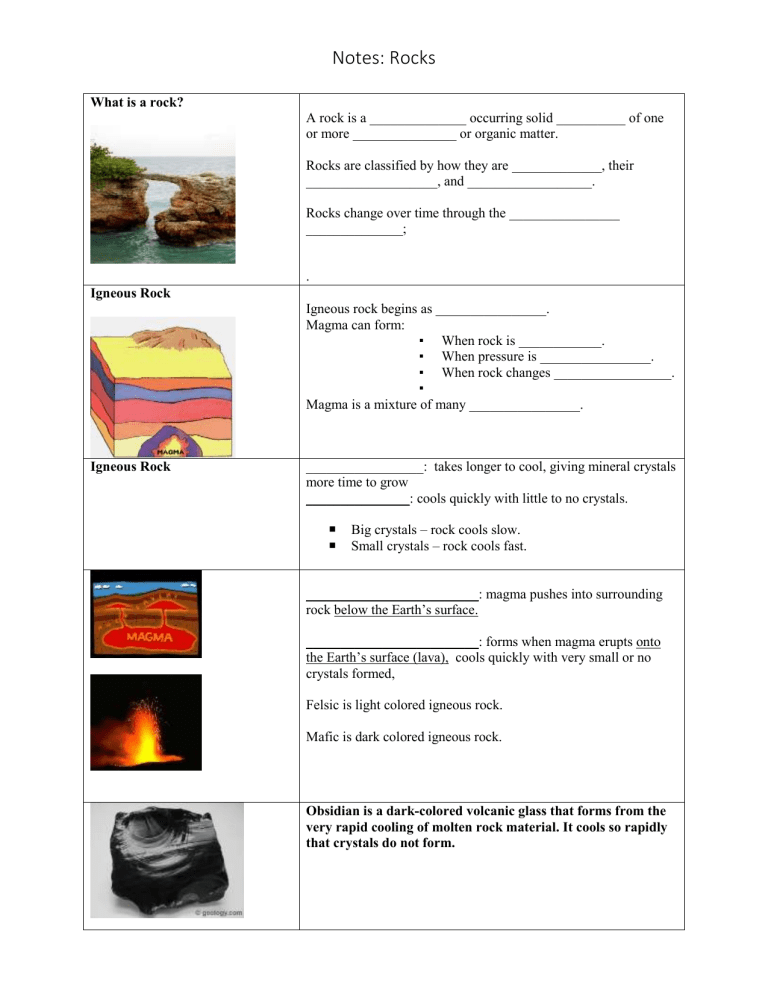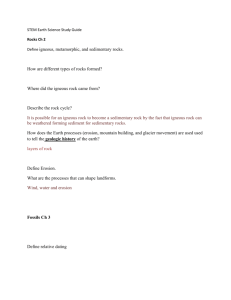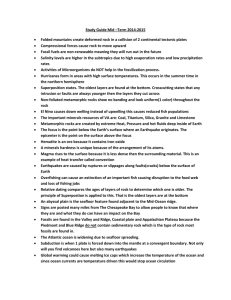Notes: Rocks

What is a rock?
Igneous Rock
Igneous Rock
Notes: Rocks
A rock is a ______________ occurring solid __________ of one or more _______________ or organic matter.
Rocks are classified by how they are _____________, their
___________________, and __________________.
.
Rocks change over time through the ________________
______________;
Igneous rock begins as ________________.
Magma can form:
▪
When rock is ____________.
▪
When pressure is ________________.
▪
When rock changes _________________.
▪
Magma is a mixture of many ________________.
_________________: takes longer to cool, giving mineral crystals more time to grow
_______________: cools quickly with little to no crystals.
Big crystals – rock cools slow.
Small crystals – rock cools fast.
_________________________: magma pushes into surrounding rock below the Earth’s surface.
_________________________: forms when magma erupts onto the Earth’s surface (lava), cools quickly with very small or no crystals formed,
Felsic is light colored igneous rock.
Mafic is dark colored igneous rock.
Obsidian is a dark-colored volcanic glass that forms from the very rapid cooling of molten rock material. It cools so rapidly that crystals do not form.
Metamorphic Rock
Notes: Rocks
Metamorphic -
Means to ______________ shape.
Changes with _____________ and ______________, but remains solid.
Usually takes place ________________ in the Earth.
________________ - contains aligned grains of flat minerals
(lines).
Sedimentary Rocks
_____________________– mineral grains are not arranged in plains or bands.
Sedimentary rock is formed by _______________.
Sediments are moved from one place to another.
Sediments are ___________________ in layers, with the older ones on the bottom.
The layers become _______________ and
_____________together.
Sedimentary Rocks
Sedimentary Rocks are formed at or near the Earth’s surface
No heat and pressure involved.
Fossils found in these rocks
_____________ – layers of rock
_________________ – the process in which sedimentary rocks are arranged in layers.
_______________ – made of fragments of rock cemented together with calcite or quartz.
___________________________ – minerals crystallize out of
Rock Cycle
Rock Cycle
Fossils
Types of Fossils
Petrified Fossils
Molds and Casts
Notes: Rocks solution (water) to become rock.
___________________________ – remains of plants and animals.
The __________________ changing of rocks from one kind to another over long periods of time is called the __________
_____________________.
The rock cycle has no definite sequence. It can follow many different pathways.
Igneous : Melting to Magma/Volcanic Activity
Sedimentary : Erosion – Weathering-Deposition -
Cementation – Compaction
Metamorphic : Heat and Pressure
Fossils are found in ____________________ rocks.
They help provide information of life forms that lived thousands of years ago.
_________________ – Minerals have filled in where an organism once was.
_____________ – A hollow area that an organism has left.
____________ – A copy of the shape of the organism
(opposite of a mold)
_______________________ – a thin coating of carbon that is left behind when gases have been release by the decaying fossil (like a leaf print on a rock)
_______________ – An imprint that an organism left behind (like a footprint)
.
Fossils in which minerals _____________ all or part of an organism.
How does this happen?
Water rich in dissolved minerals ___________ into spaces, evaporated, leaving the
________________minerals behind.
Example – petrified wood
Most __________________ type of fossil.
Both _______________ the shape of the organism.
Carbon Film
Trace Fossils
How Old Is It?
Notes: Rocks
A mold is a ___________________ area of sediment in the shape of the organism.
A cast is a ________________ of the shape of an organism.
Carbon film is an extremely ____________coating of carbon
How does this happen?
All organisms are made of carbon. When they are buried, the materials that makes up the organism
___________________. These gases escape leaving carbon behind.
Trace fossils provide _____________ of the activities of ancient organisms.
Examples
A ___________________ provides clues about the size and behavior, the speed, how many legs it walked on, lived alone or with others.
A ___________ or _____________ can give clues about the size and shape of the organism, where it lived, and how it obtained food.
_____________________ – It’s age when compared to others ( I am older than you)
_____________________ – It’s actual or real age
We use radioactive dating to find this
____________________ – a gap in the geological record (like from erosion)








